

SDL Trados training – total crock or benefit? Posted by Jill (@bonnjill) in Tools, Translation Sites.
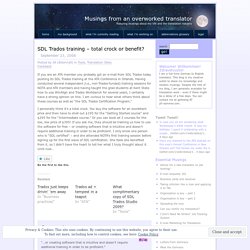
Trackback If you are an ATA member you probably got an e-mail from SDL Trados today pushing its SDL Trados training at the ATA Conference in Orlando. Having conducted several independent (i.e., non-Trados-funded) training sessions for NOTA and ATA members and having taught the grad students at Kent State how to use WinAlign and Trados Workbench for several years, I certainly have a strong opinion on this. Yet again: Trados fuzzy match woes (Expanded) Continuing from my post of August 25, some further evidence of just how badly designed the fuzzy matching algorithms are in Trados: So, according to Trados, "INSTALLING DISPLAY" is a 67% match for "Installing Display", while "Ownership of the Services and Marks.
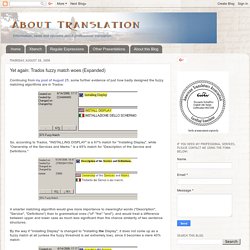
" is a 65% match for "Description of the Service and Definitions. " A smarter matching algorithm would give more importance to meaningful words ("Description", "Service", "Definitions") than to grammatical ones ("of" "the" "and"), and would treat a difference between upper and lower case as much less significant than the chance similarity of two sentence structures.
By the way if "Installing Display" is changed to "Installing the Display", it does not come up as a fuzzy match at all (unless the fuzzy threshold is set extremely low), since it becomes a mere 40% match: The worse thing is that all these problems have been known for years, but Trados (and now SDL/Trados) programmers have done nothing to improve the situation. Les outils libres du traducteur, un écosystème à apprivoiser. 1Pour nombre de traducteurs, les outils de Traduction Assistée par Ordinateur font maintenant partie du quotidien, au même titre que le traitement de texte et le navigateur web.

Évoquer l’existence de logiciels libres dans cette catégorie suscite fréquemment des questions sur la nécessité d’utiliser Linux, ou sur la gratuité. Cet article tente de répondre à ces questions, et présente quelques‑uns de ces logiciels : OmegaT, logiciel de TAO, Okapi, un ensemble de composants dédiés à la localisation et à la traduction, et bitext2tmx, Bligner et LF Aligner, trois logiciels d’alignement. 2Il y a souvent confusion entre freeware et logiciel libre, en partie à cause de la ressemblance des dénominations en anglais (freeware et free software). Disons‑le sans ambiguïté, la liberté n’a que peu à voir avec la gratuité, puisqu’il est même possible de vendre des logiciels libres. 3Ce qui caractérise un logiciel libre, ce sont les quatre libertés fondamentales qu’il octroie à ses utilisateurs. 1.
Questions to Ask Before You Accept a Translation Project. It is impossible to anticipate every issue or question that may arise during the course of a translation project, but one thing you can do to be prepared before you get started is ask a lot of questions.
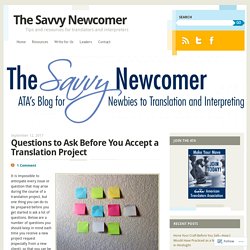
Below are a number of questions you should keep in mind each time you receive a new project request (especially from a new client), so that you can be sure to avoid any surprises or problems down the road. You can use this as a sort of checklist each time you receive a new request; be sure to glance through each topic and consider the answers to all the questions we’ve listed before you even quote the job. You don’t necessarily need to ask the client all of these questions for each project you quote—just remember that addressing these topics as early as possible will help clear up any misunderstandings, make you appear professional, and ensure that your client will be as satisfied as possible in the end. The Task at Hand Does the client need translation only or translation and editing?
A New “Murmuration” Among Translators: The Starling Bureau. Starling murmuration.
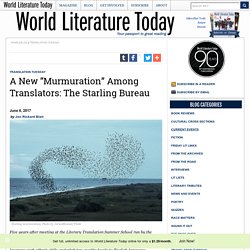
Photo by Airwolfhound/Flickr Five years after meeting at the Literary Translation Summer School run by the British Centre for Literary Translation, translators Morgan Giles, Ruth Clarke, Roland Glasser, Paul Russell Garett, and Zoë Perry have started a collective to leverage each other’s skills and pitch top-quality books to English-language publishers. In this interview, Roland Glasser shares how the collective formed, what they are doing to transform the process of pitching books to publishers, and how their collective ties into the ongoing conversation about improving translators’ rights. Jen Rickard Blair: How was the idea for the Starling Bureau born?
Agessa. Domaines de spécialisation. Ressources traducteur. Automation: The Key to Translation Speed. Administratif. Article. Estilo, tipografía y ortotipografía del español. Ortotipografía y tipografía Ortografía, tipografía y ortotipografía • Breve introducción.
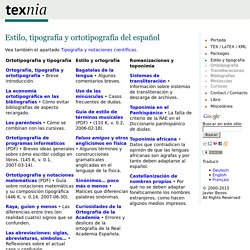
La economía ortotipográfica en las bibliografías • Cómo evitar bibliografías de aspecto recargado. Los paréntesis • Cómo se combinan con las cursivas. Ortotipografía de programas informáticos (PDF) • Breves ideas generales sobre cómo escribir código en libros. (145 K, v. 0.1, 2007-03-14). Ortotipografía y notaciones matemáticas (PDF) • Guía sobre notaciones matemáticas y su composición tipográfica (446 K, v. 0.14, 2007-06-30). Raya, guion y menos • Las diferencias entre tres (en realidad cuatro) signos que se confunden. Las abreviaciones: siglas, abreviaturas, símbolos… • Reflexiones sobre el actual caos y confusión. Abreviaturas comerciales • Su tratatamiento ortotipográfico.
Traduction et SEO. Construction Site web. Translator's Serendipity. Forum traducteurs. Relations clients. Organisations professionnelles traducteurs. Blogs traduction. Outils. Formations traducteurs.